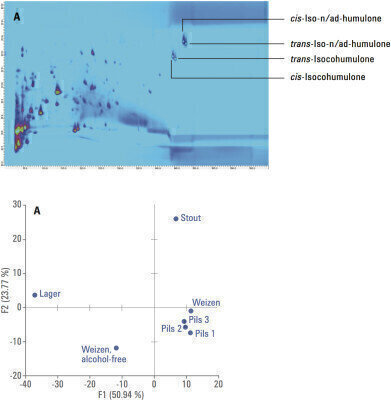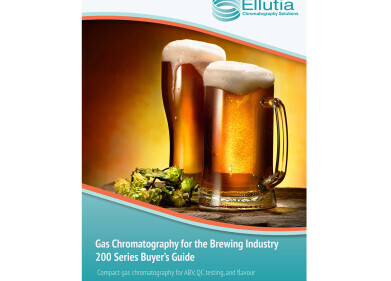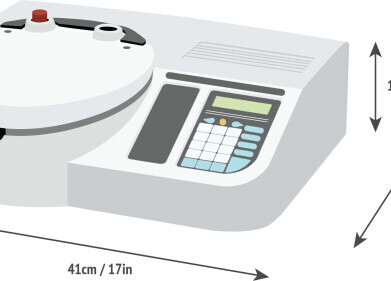Chromatography
Fingerprinting Analysis of Different Types of Beer Sonja Krieger, Agilent Technologies Inc, Waldbronn, Germany
Mar 24 2015
This Application Note demonstrates the comprehensive 2D-LC analysis of different types of beer. Nontargeted, multisample analysis (fingerprinting analysis) enabled a classification of the different types of beer analysed.
Introduction
Beer is an alcoholic beverage produced by saccharification of starch and fermentation of the resulting sugar. The basic ingredients of beer are water, malted barley or wheat, and for most beers hops [1]. The typical beer bitterness is achieved by adding hops (Humulus lupulus L.) as cones, pellets, or extracts during wort boiling and results from iso-α-acids (isohumulones) and polyphenolic compounds [2,3]. Because of the highly complex composition of beer, comprehensive 2D-LC is ideally suited for a comprehensive analysis of beer.
Experimental Conditions
Comprehensive 2D-LC analysis was achieved with the Agilent 1290 Infinity 2D-LC solution. In the first dimension an Agilent ZORBAX Narrow-Bore RR Extend-C18 column (2.1 x 100 mm, 3.5 µm) was used with a gradient of 5 mM ammonium acetate in water, adjusted to pH 9.95 with ammonia, and acetonitrile/ethanol (60/40, v/v) at a flow rate of 0.075 mL/min. The second-dimension separation used an Agilent Poroshell HPH-C18 column (4.6 x 50 mm, 2.7 µm) with shifted gradients of water and acetonitrile, each with 0.25 % formic acid, at a flow rate of 4.0 mL/min. Modulation was realised using the Agilent 2-position/4-port duo-valve, equipped with two 60-µL loops. A modulation time of 21 seconds was deployed. Diode array detection at 270 nm as well as mass spectrometric detection in negative ionisation mode was performed. Beer samples were degassed and filtered before injection into the HPLC system.
Results
A comprehensive 2D-LC method was developed for the fingerprinting analysis of different types of beer. Panel A in Figure 1 exemplarily shows the chromatogram of the analysis of one German weizen beer with UV detection at 270 nm. It can be seen that a good coverage of the two-dimensional separation space was achieved by using C18 columns with alkaline and acidic pH values in the first- and second-dimension separations, respectively.
For comparison and classification of the different beer samples analysed, a nontargeted, multisample analysis comparing every constituent in every sample was used. For this purpose, a cross-sample feature matching with generation of a composite chromatogram was performed. The composite chromatogram contains all peaks from all chromatograms and is used to define peak-region features (feature areas). For each chromatogram, the % response for each of the defined feature areas is calculated. Classification of the analysed beer samples was performed by principal component analysis (PCA) using the defined feature areas with their respective % responses for every sample. Using PCA, the beer samples could be classified according to their type, as shown in panel B of Figure 1.
Figure 1: (A) Comprehensive 2D-LC analysis of German weizen beer with UV detection at 270 nm; (B) Principal component analysis of seven different beer samples.
Conclusions
The comprehensive 2D-LC analysis of different types of beer using C18 columns at alkaline and acidic pH values in the first and second dimension, respectively, provides good orthogonality. By nontargeted, multisample analysis followed by principal component analysis, it was possible to classify the different types of beer analysed.
References
1. Araujo, A. S., et al., Analyst, 2005, 130, 884–889
2. Intelmann, D., et al., J. Agric. Food Chem., 2009, 57, 1172–1182
3. Ceslova, L., et al., J. Chromatogr. A, 2009, 1216, 7249–7257
Digital Edition
Lab Asia Dec 2025
December 2025
Chromatography Articles- Cutting-edge sample preparation tools help laboratories to stay ahead of the curveMass Spectrometry & Spectroscopy Articles- Unlocking the complexity of metabolomics: Pushi...
View all digital editions
Events
Jan 21 2026 Tokyo, Japan
Jan 28 2026 Tokyo, Japan
Jan 29 2026 New Delhi, India
Feb 07 2026 Boston, MA, USA
Asia Pharma Expo/Asia Lab Expo
Feb 12 2026 Dhaka, Bangladesh



















